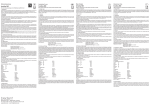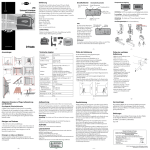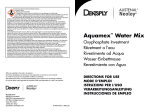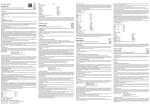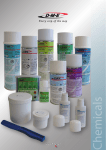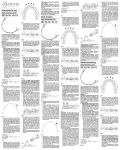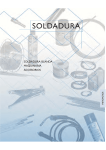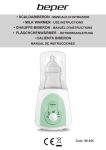Download DIRECTIONS FOR USE MODE D`EMpLOI
Transcript
EINSTELLUNgENDENTSpLYAUSTENALECMIV gUSSgERÄT Einstellung Gießtemperatur:. .....1550ºC Vitallium-Skala Haltezeit-Timer:...........................................5 Sekunden Schmelz-Wahlschalter: ..........................Auf High (Hoch) EINSTELLUNgFLAMMEN-gUSSgERÄT: Kleine Gussobjekte - 50 Großes Gussobjekt - 75 bis 100 UPM: 380-400 Das Gegengewicht des Zentrifugalarms auf die korrekte Position einstellen, um für einen reibungslosen und balancierten Gussvorgang zu sorgen. Befolgen Sie die Anweisungen für das von Ihnen verwendete Gussgerät. Die Legierung schmelzen, in die vorgewärmte Muffel gießen und die Muffel vor der weiteren Verarbeitung auf dem Arbeitstisch abkühlen lassen. MUFFELN NICHT RASCH ABKÜHLEN ODER ABSCHRECKEN, DA DIES ZU EINEM VERZIEHEN DER GUSSOBJEKTE & UND UNERWÜNSCHTEN VERÄNDERUNGEN DER MECHANISCHEN EIGENSCHAFTEN DER LEGIERUNG FÜHREN KANN. ANWEISUNgFüRDASgIESSEN MITOFFENERFLAMME Warnhinweise:Beim Schmelzen und Gießen mit offener Flamme äußerste Vorsicht walten lassen. Die Anweisungen und Warnhinweise des Brenner-Herstellers befolgen und bei der Verwendung eines PropanSauerstoff-Brenners einen speziell hierfür entwickelten Augenschutz tragen. Je nach Spannung der Feder 3-5 Umdrehungen am Gussarms verwenden. Das Gegengewicht entsprechend der Größe des zu gießenden Objekts auf die korrekte Position einstellen. Druckregler und Durchflussmesser für SauerstoffAcetylen-Schmelzbrenner verwenden. Vorgewärmte Muffel und Gusstiegel in das Gussgerät setzen. Erforderliche Menge der Gusslegierung in den Tiegel geben. Brenner anzünden und die Flamme langsam und kreisförmig über das Metall bewegen. Diese Bewegung fortsetzen, um die Legierung gleichmäßig zu erhitzen und zu schmelzen. Wenn die Legierung zu schmelzen beginnt, fallen die Gusswürfel und Gusskegel zusammen. Die Legierung weiter gleichmäßig erhitzen, bis zu sehen ist, wie die geschmolzene Legierung zusammenfließt und sich unter dem Druck der Flamme bewegt. Die Legierung NICHT überhitzen. Anmerkung:DerOxidfilmsolltenichtreißen. Den Gussarm freigeben und schleudern lassen, bis er zum Stillstand gekommen ist. Muffel herausnehmen und vor der weiteren Verarbeitung auf dem Arbeitstisch abkühlen lassen. MUFFELN NICHT RASCH ABKÜHLEN ODER ABSCHRECKEN, DA DIES ZU EINEM VERZIEHEN DER GUSSOBJEKTE & UND UNERWÜNSCHTEN VERÄNDERUNGEN DER MECHANISCHEN EIGENSCHAFTEN DER LEGIERUNG FÜHREN KANN. AUSARbEITENUNDObERFLÄCHENpRÄpARATION Bei der Oberflächenpräparation sowie der Herstellung chirurgischer Implantate ist die Standard-Praxis gemäß ASTM 86-84 in Bezug auf empfohlene Reinigungs- und Passivierungsverfahren zu befolgen. pHYSIKALISCHE&MECHANISCHEEIgENSCHAFTEN 0,2- %-Dehngrenze ..........................................572 MPa Zugfestigkeit....................................................799 MPa Elastizitätsmodul..............................................200 GPa Bruchdehnung..................................................... 7,0 % Vickers-Härte ...................................................410 HV5 Dichte ........................................................... 8,3 g/cm3 Farbe ..................................................................... grau Schmelzintervall ......................................1300-1370 °C zusammensetzung(gewichts%) Kobalt ................................................................61,6 % Chrom ................................................................29,5 % Molybdän.............................................................6,5 % Mn, Si, C < 1,0% Die Legierung Vitallium Special enthält weder Nickel noch Beryllium. Indicaciones La aleación especial Vitalliun es una aleación de metales básicos predominantemente que está indicada para el moldeado de los implantes subperiósticos. Contraindicaciones 1. La aleación Vitallium Special está contraindicada en pacientes y usuarios con antecedentes de sensibilidad al cobalto, cromo y molibdeno. Advertencias 1. La exposición prolongada a los humos y/o polvos de la aleación puede causar irritación pulmonar y/o complicaciones pulmonares. Utilice los controles de ingeniería apropiados para limitar la exposición. En los casos de excesiva inhalación de humos o polvos, busque atención médica. 2. Esta aleación contiene cromo. Algunos compuestos de estos elementos tienen potencial carcinógeno. Informe a su proveedor médico de la exposición a estos elementos. 3. Esta aleación contiene elementos conocidos en California por ser carcinógenos. precauciones 1. Cuando funda, rebaje o pula aleaciones, utilice la ventilación adecuada, sistemas de aspiración o vacío, protección ocular, y ropa y mascarillas protectoras. Reaccionesadversas 1. La exposición a los humos o al polvo de la aleación puede causar irritación ocular y/o complicaciones respiratorias. 2. Determinados componentes de las aleaciones tienen potencial carcinógeno. Vea el apartado “Advertencias”. INSTRUCCIONES PASO A PASO pROCESSINgINSTRUCTIONS: Recomendacionespararevestimiento:Utilice un sistema de revestimiento con silicato de etilo de DENTSPLY Austenal: Nº ref. Revestimiento VR™ .................. N022065, EU8022065 VR Binder....................................N023001, EU8023005 VR Binder Thinner .......................N024001, EU8024005 Recomendacionesparaelmaterialdeduplicación: Use material reversible hidrocoloide de duplicación perflex® (nº ref. N021055) con el revestimiento VR. El material de duplicación Silflex® III de polivinil siloxano (nº ref. N021501) se recomienda para usarlo en la duplicación de modelos en moldes con dispositivos de sujeción de precisión y para moldes de combinación. NOTA:Sigalasinstruccionesdelmaterialde revestimientoyduplicaciónqueestéutilizandopara modelosrefractariosylospasosderevestimiento. EQUIpO: REQUISITOSDELHORNODEQUEMADO: pararevestimientoVR: Horno de gas de alta temperatura capaz de alcanzar una temperatura de 1177 °C (2150 °F). MÁQUINASDEMODELADO: Máquina de modelado DENTSPLY Austenal ECM IV o una Máquina de modelado con soplete, esto es un soplete de oxígeno acetileno de múltiples orificios y brazo centrífugo de modelado activado por resorte. INSTRUCCIONESDEQUEMADO:Precalentar los moldes de revestimiento y un crisol limpio de modelado siguiendo el ciclo recomendado de quemado para el revestimiento que se vaya a utilizar. Asegúrese de que los crisoles solamente se utilizan para esta aleación y que los crisoles utilizados no tienen escoria ni ningún resto de metal. INSTRUCCIONESDEMODELADO: Relacióndemetalvirgen/reusado: Se recomienda metal virgen 100% cuando se moldean implantes dentales. pARÁMETROSDELAMÁQUINADEMODELADO DENTSpLYAUSTENALECMIV Ajuste de la temperatura de modelado: .......... 2820°F Vitallium Scale Temporizador de remojo: ............................... 5 segundos Selector de fusión:..................................................... Alto Ajustedelreductordeaceleración: Moldes pequeños - 50 Moldes grandes - 75 a 100 RPM: 380-400 Ajuste el peso del contador del brazo centrífugo en la posición adecuada para permitir una operación de modelado equilibrada y suave. Siga las instrucciones de la máquina que esté usando. Funda y modele la aleación en el molde precalentado de revestimiento y deje que los moldes se enfríen en la mesa de trabajo antes de procesarlos más. NO FUERCE EL PROCESO DE ENFRIAMIENTO NI ENFRÍE RÁPIDAMENTE LOS MOLDES YA QUE ESTO PODRÍA CAUSAR LA DEFORMACIÓN DE LOS MOLDES Y CAMBIOS NO DESEADOS EN LAS PROPIEDADES MECÁNICAS DE LA ALEACIÓN. INSTRUCCIONESDEMODELADOCONSOpLETE: Advertencia: Tenga extremo cuidado durante las operaciones de fusión con soplete. Siga las instrucciones y advertencias del fabricante del soplete y utilice equipo de protección para los ojos diseñado para utilizarlo cuando se use un soplete de oxígeno acetileno. Use 3-5 vueltas en el brazo de modelado dependiendo de la tensión del resorte. Ajuste las contrapesas en la posición correcta de acuerdo al tamaño del molde que se vaya a modelar. Coloque un soplete de oxígeno acetileno de múltiples orificios con reguladores de presión y caudalímetros. Coloque el molde precalentado y el crisol en la máquina de modelado. Coloque la cantidad necesaria de aleación en el crisol. Encienda el soplete y con un movimiento circular, mueva la llama lentamente sobre el metal. Continúe con este movimiento para calentar y fundir uniformemente la aleación. Cuando la aleación empieza a fundirse, los lingotes y botones se colapsarán. Añada fundente y siga calentando uniformemente la aleación hasta que pueda verse que la aleación fundida se desliza y mueve bajo la presión de la llama. NO calentar excesivamente la aleación. Nota:Lapelículadeóxidonodeberomperse. Libere el brazo de modelado y deje que éste se pare totalmente. Retire el molde y deje que se enfríe en la mesa de trabajo antes de procesarlo más. NO FUERCE EL PROCESO DE ENFRIAMIENTO NI ENFRÍE RÁPIDAMENTE LOS MOLDES YA QUE ESTO PODRÍA CAUSAR LA DEFORMACIÓN DE LOS MOLDES Y CAMBIOS NO DESEADOS EN LAS PROPIEDADES MECÁNICAS DE LA ALEACIÓN. pREpARACIóNDELASUpERFICIEYACAbADO Consulte en la práctica estándar ASTM 86-84 los procedimientos recomendados de pasivación y limpieza para la preparación de la superficie y creación de implantes quirúrgicos. pROpIEDADESFÍSICASYMECÁNICAS Límite de alargamiento 0,2% ......... 83.000 psi (572 MPa) Resistencia final a la tracción........ 116.000 psi (799 MPa) Módulo de elasticidad ....................29,000 kpsi (200 GPa) Porcentaje de elongación ......................................... 7,0% Dureza Vickers ................................................... 410 HV5 Densidad............................................................. 8,3 g/cc Intervalo de fusión ...............1300-1370°C (2375-2500°F) Composición(%masa) Cobalto.................................................................. 61,6% Cromo.................................................................... 29,5% Molibdeno ............................................................... 6,5% Mn, Si, C < 1,0% La fórmula de la aleación Vitallium Special no contiene níquel ni berilio. Indicaties Vitallium Special is een kobalt basis legering in eerste instantie voor het vervaardigen van subperiosteal implantaten. Contra-indicaties 1. Vitallium Special niet gebruiken indien bekend is dat de patiënt of gebruiker overgevoelig is voor kobalt, chroom en molybdeen. Waarschuwingen 1. Langdurige blootstelling aan stof en/of dampen van de legering kunnen leiden tot irritatie van de longen en/of tot ademhalingsproblemen. Raadpleeg het veiligheids informatieblad voor meer informatie. 2. Deze legering bevat chroom. Bepaalde chroom .verbindingen zijn mogelijk kankerverwekkend. Raadpleeg een arts wanneer blootstelling aan deze elementen heeft plaatsgevonden. 3. Deze legering bevat elementen die in de Amerikaanse staat Californië als kankerverwekkend gelden. Voorzorgsmaatregelen 1. Zorg bij het smelten, beslijpen of polijsten van legeringen voor goede ventilatie en maak gebruik van een afzuiginstallatie. Draag bij bewerking een beschermende bril, een beschermend mondmasker en beschermende kleding. bijwerkingen 1. Blootstelling aan stof en/of dampen van de legering kunnen leiden tot irritatie van de ogen en/of tot ademhalingsproblemen. 2. Enkele bestanddelen van legeringen zijn mogelijk kankerverwekkend. Zie de waarschuwingen. Raadpleeg het veiligheidsinformatieblad. STAPSGEWIJZE AANPAK INSTRUCTIESVOORVERWERKINg: Adviezenvoorhetinbedden: Gebruik een ethylsilicaat gebonden inbedsysteem van DENTSPLY Austenal: bestelnummers voor nabestellingen Inbedsysteem: Bestelnummer Inbedmassa VR™ ...........................N022065, EU8022065 VR Binder .......................................N023001, EU8023005 VR Binder Thinner...........................N024001, EU8024005 Aanbevelingenvoorhetdupliceermateriaal: Gebruik bij Vitallium inbedmassa het perflex® reversibele hydrocolloïd-dupliceermateriaal (bestelnummer: N021055, EU8021055) met VR investment. Voor het dupliceren van modellen met precisieattachments en gecombineerde voorzieningen wordt het polyvinylsiloxaan-dupliceermateriaal Silflex® III (bestelnummer N021501) aangeraden. Voor EU gebruikers bevelen wij bij deze indicatie Silflex Blue (Shore25) Art.Nr. 8021550-8021560 Componente A&B 5kg aan. OpMERKINg:Volgdeinstructiesvoorhetinbed-en dupliceermateriaalopdatugebruiktvoorhetvuurvaste modelenhetinbedden. gIETMACHINES: De DENTSPLY Austenal ECM IV gietmachine of een vlamgietapparaat, d.w.z. een centrifugale gietarm met veeractivering, met een propaan-zuurstof brander. Alloy/Alliage/ Lega/Legierung/ Aleación/ Dentaal– giet- legering Dental Casting Alloy, Type 5 Alliage de coulée dentaire, type 5 Lega di fusione dentale, tipo 5 Dentale Gusslegierung des Typs 5 Aleación de moldeo dental, tipo 5 Dentale gietlegering, Type 5 ISO 22674 DIRECTIONSFORUSE MODED’EMpLOI ISTRUzIONIpERL’USO VERARbEITUNgSANLEITUNg INSTRUCCIONESDEEMpLEO INSTRUCTIESVOORHETVOORVERWARMEN: Verwarm de gietmoffels en een schone gietkroes conform de voor de gebruikte inbedmassa aanbevolen voorverwarmcyclus. INSTRUCTIESVOORHETgIETEN: 100% nieuwe metaal is aanbevolen voor het gieten van dentale implantaten Zorg dat eerder gegoten kegels en kanalen grondig worden gezandstraald en gereinigd voor dat ze opnieuw voor het gieten worden gebruikt. Door dit advies op te volgen blijft de chemische samenstelling van de legering constant en vormen zich zo min mogelijk oxiden en slakken (een van de hoofdoorzaken van insluitingen in gietobjecten). INSTELLINgENVANDEDENTSpLYAUSTENALECMIV gIETMACHINE Instelling giettemperatuur:..............1550ºC Vitallium-scala Timer voor de houdtijd: ....................................5 seconden Smeltkeuzeschakelaar: ...............................Op hoog (high) INSTELLINgSlingergiet-apparaat: Kleine gietobjecten – 50, groot gietobject – 75 à 100 Toerental: 380-400 Stel het contragewicht van de centrifugearm in op de juiste positie, zodat een soepel en uitgebalanceerd gietprocédé mogelijk is. Volg de instructies voor de door u gebruikte gietmachine op. Smelt de legering, giet hem in de voorverwarmde moffel en laat de moffel voor verdere verwerking afkoelen op de werktafel. KOEL DE MOFFELS NIET SNEL AF EN LAAT ZE NIET AFSCHRIKKEN. DIT KAN VERVORMING VAN DE GIETOBJECTEN VEROORZAKEN EN KAN ONGEWENSTE MECHANISCHE VERANDERINGEN IN DE LEGERING TEWEEGBRENGEN. INSTRUCTIESVOORHETgIETENMETOpENVLAM: Waarschuwingen: Ga bij het smelten en gieten met open vlam zeer voorzichtig te werk. Houd u daarbij aan de instructies en waarschuwingen van de fabrikant van de brander en draag bij het werken met propaanzuurstofbranders een speciale beschermingsbril. Werk, al naar gelang de spanning op de veer, met minimaal 3 tot 5 draaiingen van de centrifugearm. Stel het contragewicht afhankelijk van de moffelgrootte van het te gieten object in op de juiste positie. Gebruik een propaan-zuurstoffbrander met drukregeling en debietmeter. Plaats de voorverwarmde moffel en de gietkroes in het gietapparaat. Doe de juiste hoeveelheid van de gietlegering in de smeltkroes. Steek de brander aan en beweeg de vlam in langzaam draaiende beweging over het metaal. Ga met deze beweging door tot de legering gelijkmatig verwarmd is en gaat smelten. Wanneer de legering begint te smelten, vallen de gietblokjes en gietkegels uiteen. Blijf de legering steeds gelijkmatig verhitten, tot de vloeibare legering samenvloeit en zich onder de vlamdruk beweegt. Zorg dat de legering NIET OVERVERHIT raakt! Opmerking:Deoxidefilmmagnietscheuren. Ontgrendel de gietarm en laat deze slingeren tot hij tot stilstand is gekomen. Neem de moffel uit de brander en laat hem op de werktafel afkoelen voordat er verder mee wordt gewerkt. KOEL DE MOFFELS NIET SNEL AF EN LAAT ZE NIET AFSCHRIKKEN. DIT KAN VERVORMING VAN DE GIETOBJECTEN VEROORZAKEN EN KAN ONGEWENSTE MECHANISCHE VERANDERINGEN TEWEEGBRENGEN IN DE LEGERING. FYSISCHEENMECHANISCHEEIgENSCHAppEN 0,2-%-vloeigrens ..................................................572 MPa Treksterkte ...........................................................799 MPa Elasticiteitsmodule ...............................................200 GPa Breekrek....................................................................7,0% Vickershardheid....................................................410 HV5 Dichtheid............................................................8,3 g/cm3 Smeltinterval.................................................1300-1370°C Samenstelling(gewicht%) Kobalt......................................................................61,6% Chroom....................................................................29,5% Molybdeen................................................................ 6,5% Mn, Si, C < 1,0% De legering Vitallium Special bevat geen nikkel en geen beryllium Warning: This product contains substance(s) known to the State of California to cause cancer, or other reproductive harm. (Calif. Prop. 65) Avertissement : ce produit contient une ou des substance(s) reconnues par l’Etat de Californie comme étant cause de cancer ou d’autre atteinte au système reproductif. (Calif. Prop. 65) Avvertenza: Questo prodotto contiene sostanze che lo Stato della California considera cancerogene o che possono provocare altri danni al sistema riproduttivo. (Calif. Prop. 65) Warnhinweis: Dieses Produkt enthält Substanzen, die im Staat Kalifornien als Ursache für Krebs oder andere Fortpflanzungsschäden bekannt sind. (Calif. Prop. 65) Advertencia: Esta producto contiene sustancias conocidas en el estado de California por causar cáncer u otros daños en el aparato reproductor. (Calif. Prop 65) Waarschuwing: Dit product bevat stoffen die in de Amerikaanse staat Californië gelden als kankerverwekkend dan wel als oorzaak van andere voortplantingsschade. (Calif. Prop. 65) Manufacturer DENTSPLY Austenal DENTSPLY International Inc. York, PA 17405-0872 1-800-243-1942 www.prosthetics.dentsply.com www.dentsply.com Elephant Dental B.V. Verlengde Lageweg 10 1628 PM Hoorn The Netherlands +31 229 25 90 00 www.elephant.dental.com Vitallium® Trademark is licensed to DENTSPLY Austenal by SMD Corporation. Perflex®, Polyflex®, and Silflex® are registered trademarks of DENTSPLY Austenal. La marque de commerce Vitallium® est brevetée Austenal DENTSPLY par SMD Corporation. Perflex®, Polyflex® et Silflex® sont des marques déposées d’Austenal DENTSPLY. Il marchio registrato Vitallium® è concesso in licenza a DENTSPLY Austenal da SMD Corporation. Perflex®, Polyflex® e Silflex® sono marchi registrati di DENTSPLY Austenal. Das Warenzeichen Vitallium® ist lizenziert für DENTSPLY Austenal durch die SMD Corporation. Perflex®, Polyflex® und Silflex® sind eingetragene Warenzeichen von DENTSPLY Austenal. SMD Corporation ha autorizado a DENTSPLY Austenal para usar la marca comercial Vitallium®. Perflex®, Polyflex® y Silflex® son marcas registradas de DENTSPLY Austenal. De merknaam Vitallium® is gelicenseerd voor DENTSPLY Austenal door SMD Corporation. Perflex®, Polyflex® en Silflex® zijn gedeponeerde merknamen van DENTSPLY Austenal. MSDS is available on the web or by request. Des fiches signalétiques et techniques sont disponibles sur Internet ou sur demande. Le schede di sicurezza sono disponibili sul Web o su richiesta. MSDS (Material Safety Data Sheets, Sicherheitsdatenblätter) sind im Internet und auf Anfrage erhältlich. La ficha de datos sobre seguridad de materiales (MSDS) está disponible en la web o por petición. Het veiligheidsinformatieblad (VIB) is op internet en op aanvraag beschikbaar. ©2006, 2011 DENTSPLY International Inc. All rights reserved. Made & Printed in U.S.A. NPK0877 Rev. F (08/11) Indications Vitallium Special Alloy is a predominantly base metal alloy indicated for casting subperiosteal implants. Contraindications 1. Vitallium Special Alloy is contraindicated for patients and users with a history of sensitivity to cobalt, chromium, and molybdenum. Warnings 1. Prolonged exposure to alloy dust and/or fumes may lead to lung irritation, and/or pulmonary complications. Use appropriate engineering controls to limit exposure. For excessive inhalation of dust or fumes, seek medical advice. 2. This alloy contains chromium. Some compounds of this element are potential carcinogens. Advise your health care provider of exposure to this element. 3. This alloy contains elements that are known to the State of California to be carcinogenic. precautions 1. When melting, grinding, or polishing alloys, use adequate ventilation, vacuum systems, protective eyewear, and protective masks and clothing. AdverseReactions 1. Exposure to alloy dust or fumes may cause eye irritation and/or respiratory complications. 2. Certain components of alloys are potential carcinogens. See Warnings. STEP BY STEP INSTRUCTIONS pROCESSINgINSTRUCTIONS InvestmentRecommendations: Use DENTSPLY Austenal’s Ethyl Silicate Bonded Investment System: ReOrder# VR™ Investment ........................................... N022065 VR Binder...................................................... N023001 VR Binder Thinner.......................................... N024001 DuplicatingMaterialRecommendations: Use perflex® Reversible Hydrocolloid Duplicating Material (ReOrder# N021055) with VR Investment. Silflex® III Polyvinyl Siloxane Duplicating Material (ReOrder# N021501) is recommended for use for model duplication for cases with precision attachments and for combination cases. NOTE:Followtheinstructionsfortheinvestmentand duplicatingmaterialthatyouareusingforrefractory modelandinvestingsteps. EQUIpMENT bURNOUTFURNACEREQUIREMENTS ForVRInvestment:High temperature gas fired burnout furnace capable of attaining 2150°F (1177°C). CASTINgMACHINES: DENTSPLY Austenal ECM IV Casting Machine or a Torch Casting Machine - i.e. Oxygen acetylene multi-orifice torch & spring activated centrifugal casting arm. bURNOUTINSTRUCTIONS: Preheat the investment molds and a clean casting crucible following the recommended burnout cycle for the investment being used. Make sure that crucibles are only used for this alloy and that used crucibles are clean of slag and any remaining metal. CASTINgINSTRUCTIONS: VirginMetal/RevertRatio: 100% virgin metal is recommended when casting dental implants. DENTSpLY AUSTENALECMIVCASTINgMACHINE SETTINgS Casting Temperature Setting: .... 2820°F Vitallium Scale Soak Timer: ................................................. 5 seconds Melt Selector Switch:....................................... On High AccelerationReducerSetting: Small Castings - 50 Large Casting - 75 to 100 RPM: 380-400 Adjust centrifugal arm counter weight to the proper position to provide for a smooth and balanced casting operation. Follow the instructions for the machine that you are using. Melt and cast the alloy into the preheated investment mold and allow the molds to bench cool before further processing. DO NOT FORCE COOL OR QUENCH THE MOLDS AS IT MAY CAUSE WARPAGE OF THE CASTINGS & UNDESIRABLE CHANGES IN THE MECHANICAL PROPERTIES OF THE ALLOY. TORCHCASTINgINSTRUCTIONS: Warning: Use extreme caution during torch melting operations. Follow the instructions and warnings of the torch manufacturer and wear eye protection designed for use when operating an oxygen acetylene torch. Use 3-5 turns on the casting arm depending on the tension of the spring. Set the counter weights at the correct position according to the size of the case to be cast. Use a multi-orifice oxygen acetylene torch pressure regulators and flow meters. Place the preheated mold and crucible in the casting machine. Place the required amount of alloy in the crucible. Light the torch and with a circular motion move the flame slowly over the metal. Continue this motion to uniformly heat and melt the alloy. When the alloy begins to melt, the ingots and buttons will collapse. Add flux and continue to uniformly heat the alloy until the molten alloy can be seen to slump and move under the pressure of the flame. DO NOT overheat the alloy. Composition(%bymass) Cobalt (Co)............................................................. 61.6% Chromium (Cr)........................................................ 29.5% Molybdenum (Mo) .................................................... 6.5% Mn, Si, C < 1,0% Nickel and Beryllium Free Alloy Indications L’alliage spécial en vitallium est essentiellement un alliage en métal précieux indiqué pour la coulée des implants juxtaosseux. Contre-indications 1. L’alliage Vitallium Special est contre-indiqué chez les patients et les utilisateurs avec des antécédents de sensibilités au cobalt, au chrome et au molybdène. Avertissements 1. Une exposition prolongée aux poussières et aux vapeurs d’alliage peut entraîner une irritation des poumons et/ou des complications pulmonaires. Utilisez les moyens et équipements appropriés pour limiter l’exposition. En cas d’inhalation excessive de poussières ou de vapeurs, consultez un médecin. 2. Cet alliage contient du chrome. Certains composés de cet élément sont cancérogènes. Informez votre médecin de votre exposition à cet élément. 3. Cet alliage contient des éléments que l’Etat de Californie sait qu’ils sont cancérigènes. précautions 1. Lors de la fonte, du meulage ou du polissage des alliages, utilisez une ventilation, des systèmes sous vide, des protections oculaires et des masques et vêtements de protection adéquats. Effetsindésirables 1. L’exposition aux poussières ou aux vapeurs de l’alliage peut entraîner une irritation oculaire et/ou des complications pulmonaires. 2. Certains composants de ces alliages sont carcinogènes. Reportez-vous aux avertissements. INSTRUCTIONS PAS-À-PAS INSTRUCTIONSRELATIVESAUTRAITEMENT : Recommandationsentermesderevêtement : Utiliser un système de revêtement lié au silicate d’éthyle Nº de référence Austenal de DENTSPLY : Revêtement VR™ ........................... N022065, EU8022065 VR Binder ........................................N023001, EU8023005 VR Binder Thinner............................N024001, EU8024005 Recommandationsentermesdematériaude duplication:Utiliser un matériau de duplication hydrocolloïde réversible perflex® (Nº de référence N021055) avec revêtement VR. Il est recommandé d’utiliser le matériau de duplication siloxane de polyvinyle Silflex®III (Nº de référence N021501) pour la duplication de modèle pour les prothèses amovibles à fixations de précision et pour les prothèses amovibles combinées. REMARQUE :Suivrelesinstructionsenmatièrede revêtementetdematériaudeduplicationencours d’utilisationpourlesétapesderevêtementetdemodèle réfractaire. MATERIEL : CRITEREDUFOURDECHAUFFE : pourlerevêtementVR :Un four de chauffe au gaz haute température capable d’atteindre 2150 °F (1177 °C). MACHINEACOULER : Machine à couler ECM IV Austenal DENTSPLY ou une machine à couler au chalumeau – à savoir, un bras à couler centrifuge activé par ressort et au chalumeau à orifices multiples oxyacétylénique. INSTRUCTIONSDECHAUFFE : Préchauffer les moules de revêtement et un creuset propre pour coulée suivant le cycle de brûlage recommandé pour le revêtement utilisé. S’assurer que les creusets sont utilisés uniquement pour cet alliage et que les creusets utilisés sont exempts de toutes scories et de tout résidu de métal. INSTRUCTIONSDECOULEE : Rapportmétaldepremière fusion/recyclage : Un métal 100 % pur est recommandé lors de la coulée des implants dentaires. pARAMETRESDELAMACHINEàCOULERECMIV AUSTENALDENTSpLY Paramètres de température de coulée : ..... Graduation Vitallium 2820°F Minuteur de trempage : ................................... 5 secondes Commutateur pour le choix du mode de fusion : ................................Sur High (élevé) pARAMèTRESDURéDUCTEURD’ACCéLéRATION : Petites pièces de coulé - 50 Grandes pièces de coulée - 75 à 100 Tr/min. : 380-400 Ajuster le contrepoids du bras centrifuge sur la position adéquate afin de l’adapter à une opération de pièce de coulée homogène et équilibrée. Suivre les instructions correspondant à la machine en cours d’utilisation. Fondre et couler l’alliage dans le moule de revêtement préchauffé et laisser les moules refroidir avant de poursuivre le traitement. NE PAS FORCER LE REFROIDISSEMENT OU TREMPER LES MOULES. EN EFFET, CELA POURRAIT ENTRAINER UN GAUCHISSEMENT DES PIECES DE COULEE ET DES MODIFICATIONS INDESIRABLES DES PROPRIETES MECANIQUES DE L’ALLIAGE. Release the casting arm and allow the arm to coast to a complete stop. Remove the mold and allow it to bench cool before further processing. INSTRUCTIONSDECOULEEAUCHALUMEAU : Avertissements: Procéder avec beaucoup de soin lors des opérations de fusion au chalumeau. Se conformer aux instructions et avertissements du fabricant du chalumeau et porter des protections oculaires conçues pour être utilisées lors de l’utilisation d’un chalumeau oxyacétylénique. DO NOT FORCE COOL OR QUENCH THE MOLDS AS IT MAY CAUSE WARPAGE OF THE CASTINGS & UNDESIRABLE CHANGES IN THE MECHANICAL PROPERTIES OF THE ALLOY. Utiliser 3–5 tours sur le bras à couler en fonction de la tension du ressort. Définir le contrepoids sur la bonne position selon la taille de la prothèse amovible à couler. FINISHINgANDSURFACEpREpARATION Refer to ASTM 86-84 Standard Practice for surface preparation and making of metallic surgical implants for recommended cleaning and passivation procedures. Utiliser des débitmètres et régulateurs de pression de chalumeau oxyacétylénique à orifices multiples. pHYSICAL&MECHANICALpROpERTIES 0.2% Yield Strength ................... 83,000 psi (572 MPa) Ultimate Tensile Strength ......... 116,000 psi (799 MPa) Modulus of Elasticity..................29,000 kpsi (200 GPa) Percent Elongation .............................................. 7.0% Vickers Hardness ........................................... 410 HV5 Density ........................................................... 8.3 g/cc Melting Range ................. 2375-2500°F (1300-1370°C) Allumer le chalumeau et, d’un mouvement circulaire, déplacer doucement la flamme sur le métal. Poursuivre ce mouvement pour chauffer et fondre uniformément l’alliage. Lorsque l’alliage commencera à fondre, les lingots et boutons s’effondreront. Ajouter du fondant et continuer à chauffer uniformément l’alliage jusqu’à ce que l’alliage fondu s’effondre et bouge visiblement sous la pression de la flamme. NE PAS surchauffer l’alliage. Note:Theoxidefilmshouldnotbreak. Placer le moule et le creuset préchauffés dans la machine à couler. Placer le volume requis d’alliage dans le creuset. Remarque :Lacouched’oxydenedoitpassebriser. Relâcher le bras à couler et laisser le bras glisser jusqu’à l’arrêt complet. Enlever le moule et le laisser refroidir avant de poursuivre le traitement. NE PAS FORCER LE REFROIDISSEMENT OU TREMPER LES MOULES. EN EFFET, CELA POURRAIT ENTRAINER UN GAUCHISSEMENT DES PIECES DE COULEE ET DES MODIFICATIONS INDESIRABLES DES PROPRIETES MECANIQUES DE L’ALLIAGE. IFINITIONETpRépARATIONDELASURFACE Reportez-vous à ASTM 86-84 Standard Practice pour la préparation des surfaces et la fabrication des implants métalliques chirurgicaux servant aux procédures de nettoyage et de passivation recommandées. avvertenze del produttore del cannello e indossare gli occhiali protettivi previsti per l’utilizzo di un cannello ossiacetilenico. Applicare 3-5 rotazioni al braccio di fusione a seconda della tensione della molla. Impostare i contrappesi nella posizione corretta a seconda delle dimensioni della muffola da fondere. Utilizzare i regolatori di pressione del cannello ossiacetilenico a uscite multiple e i flussometri. Collocare il modello e il crogiuolo preriscaldati nella macchina di fusione. Mettere la quantità richiesta di lega nel crogiuolo. pROpRIETESpHYSIQUESETMECANIQUES Limite d’élasticité 0,2 %................. 83,000 psi (572 MPa) Force de traction ultime ................. 116,000 psi (799 MPa) Module d’élasticité .........................29,000 kpsi (200 GPa) Coefficient d’allongement ........................................ 7,0 % Dureté Vickers ..................................................... 410 HV5 Densité ................................................................ 8,3 g/cc Accendere il cannello e con un movimento circolare muovere lentamente la fiamma sul metallo. Continuare a muovere in modo da riscaldare e fondere in modo uniforme la lega. Quando la lega inizia a fondere, i lingotti e le punte inizieranno a collassare. Aggiungere fondente e continuare a riscaldare uniformemente la lega fino a quando questa, fondendosi, non inizierà a scorrere e a muoversi sotto l’azione della fiamma. NON surriscaldare la lega. Intervalle de fusion........... 2375–2500 °F (1300–1370 °C) Nota:lapellicoladiossidonondovràrompersi. Composition(%delamasse) Cobalt .................................................................... 61,6% Chrome................................................................... 29,5% Molybdène ............................................................... 6,5% Mn, Si, C < 1,0% L’alliage Vitallium Special ne contient ni nickel ni béryllium. Rilasciare il braccio di fusione e lasciarlo andare fino al completo punto di arresto. Togliere il modello e lasciarlo asciugare prima di procedere. Indicazioni La lega speciale di vitallio è una lega metallica di base indicata oprattutto negli impianti sottoperiostei di fusione. Controindicazioni 1. La lega Vitallium Special è controindicata nei pazienti e utilizzatori con anamnesi di sensibilità al cobalto, cromo, e molibdeno. Avvertenze 1. Una prolungata esposizione alle polveri/o vapori della lega possono portare a irritazione e/o complicazioni polmonari. Adottare adeguati controlli tecnologici per limitarne l’esposizione. In presenza di un’eccessiva inalazione a polveri o vapori rivolgersi ad un medico. 2. Questa lega contiene cromo. Alcuni composti di questi elementi sono potenzialmente carcinogeni. Informare il proprio medico curante dell’esposizione a questi elementi. 3. Questa lega contiene elementi noti come cancerogeni allo Stato della California. EVITARE DI RAFFREDDARE FORZATAMENTE O DI TEMPRARE I MODELLI POICHÉ QUESTO POTREBBE DEFORMARLI E CAUSARE CAMBIAMENTI INDESIDERABILI NELLE PROPRIETÀ MECCANICHE DELLA LEGA. LUCIDATURAEpREpARAzIONEDELLASUpERFICIE Per le procedure consigliate di pulizia e di passivazione nella preparazione della superficie e fabbricaziuone di impianti chirurgici metallici, consultare la ASTM 86-84 Standard Practice. pROpRIETàFISICHEEMECCANICHE Resistenza allo snervamento 0,2%... 83.000 psi (572 MPa) Limite di resistenza alla trazione ... 116.000 psi (799 MPa) Modulo di elasticità.................... 29,000 kpsi (200 GPa)) Allungamento percentuale...................................... 7,0% Durezza Vickers ................................................ 410 HV5 Densità.............................................................. 8,3 g/cc Intervallo di fusione ........... 1300-1370°C (2375-2500°F) Composizione(%permassa) Cobalto ................................................................ 61,6% Cromo .................................................................. 29,5% Molibdeno ............................................................. 6,5% Mn, Si, C < 1,0% La formulazione della lega Vitallium Special è priva di nickel o berillio. precauzioni 1. Durante la procedura di fusione, molatura o lucidatura di leghe, instaurare una ventilazione adeguata assieme a sistemi del vuoto e indossare occhiali, maschere e indumenti protettivi. Indikationen Vitallium-Speziallegierung ist eine Basismetall-Legierung, die in erster Linie für das Gießen von subperiostal Implantaten angewendet wird. Effetticollaterali 1. L’esposizione a polveri e vapori della lega possono causare irritazione oculare e/o complicazioni respiratorie. Kontraindikationen 1. Die Legierung Vitallium Special ist bei Patienten und Anwendern mit erwiesener Empfindlichkeit gegen Kobalt, Chrom und Molybdän kontraindiziert. 2. Certi componenti delle leghe sono potenzialmente carcinogeni. Vedere Avvertenze. Warnhinweise 1. Längere Exposition gegenüber Staub und/oder Dämpfen der Legierung kann zu Lungenreizung und/oder Atemproblemen führen. Detaillierte Informationen entnehmen Sie bitte den Sicherheitsdatenblättern. ISTRUZIONI FASE PER FASE ISTRUzIONIDITRATTAMENTO Suggerimentisulrivestimento: Utilizzare un sistema di rivestimento fissato con etilsilicato DENTSPLY Austenal:. Numero per il riordino Rivestimento VR™ ..........................N022065, EU8022065 VR Binder.......................................N023001, EU8023005 VR Binder Thinner...........................N024001, EU8024005 Suggerimentisulmaterialediduplicazione Utilizzare il materiale di duplicazione idrocolloidale reversibile perflex® (numero per il riordino N021055) con rivestimento VR. Si consiglia di utilizzare il materiale di duplicazione in polivinilsilossano Silflex® III (numero per il riordino N021501) per la duplicazione di modelli per protesi con attacchi di precisione e per protesi combinate. 2. Diese Legierung enthält Chrom. Einige Bestandteile dieser Elemente sind potenziell karzinogen. Den Arzt informieren, wenn eine Exposition gegenüber diesen Elementen erfolgt ist. 3. Diese Legierung enthält Elemente, die dem Bundesstaat Kalifornien als karzinogen bekannt sind. Vorsichtsmaßnahmen 1. Beim Schmelzen, Beschleifen oder Polieren von Legierungen für entsprechende Belüftung sorgen und Absaugsysteme einsetzen. Schutzbrille, Atemschutzmaske und Schutzbekleidung tragen (siehe Sicherheitsdatenblatt). NOTA:seguireleistruzionirelativealmaterialedi rivestimentoediduplicazionechesistautilizzandoperil modellorefrattarioelefasidirivestimento. Nebenwirkungen 1. Exposition gegenüber Staub oder Dämpfen der Legierung kann zu Augenreizungen und/oder Atemproblemen führen. ATTREzzATURA 2. Einige Bestandteile von Legierungen sind potenziell karzinogen. Siehe Warnhinweise. REQUISITIDELFORNODIpRERISCALDO perrivestimentoVR:forno di preriscaldo a gas ad elevata temperatura in grado di raggiungere 1177°C (2150°F). MACCHINEDIFUSIONE: Macchina di fusione ECM IV DENTSPLY Austenal o una Macchina di fusione con cannello ossidrico- cioè braccio di fusione centrifugo attivato a molla e con cannello ossiacetilenico a uscite multiple. ISTRUzIONIDIpRERISCALDO: Preriscaldare i modelli di rivestimento ed un crogiuolo di fusione pulito attenendosi al ciclo di preriscaldo consigliato per il rivestimento utilizzato. Assicurarsi che i crogiuoli vengano utilizzati solo per questa lega e che quelli usati vengano ripuliti dalle scorie e da qualsiasi residuo metallico. ISTRUzIONIDIFUSIONE: rapportometallo vergine/revert:Durante la fusione di impianti dentali si consiglia l’utilizzo di metallo vergine al 100%. IMpOSTAzIONIDELLAMACCHINADIFUSIONEECMIV DENTSpLYAUSTENAL Impostazione della temperatura di fusione: ................ 2820°F scala Vitallium Tempo di immersione: ....................................... 5 secondi Interruttore del selettore di fusione:.......... su “High” (Alto) IMpOSTAzIONEDELRIDUTTOREDIACCELERAzIONE: Fusioni piccole - 50 Fusioni grandi - da 75 a 100 Giri/min: 380-400 Regolare il contrappeso del braccio centrifugo nella posizione appropriata per garantire un’operazione di fusione regolare e bilanciata. Seguire le istruzioni della macchina in uso. Fondere la lega nel modello di rivestimento preriscaldato e lasciar raffreddare i modelli prima di procedere. SCHRITTWEISES VORGEHEN VERARbEITUNgSANLEITUNg: EmpfehlungenzurEinbettung: Verwenden Sie ein DENTSPLY Austenal EthylsilikatGebundenes Einbettsystem: Nachbestellnummer Einbettmasse VR™........................N022065, EU8022065 VR Binder......................................N023001, EU8023005 VR Binder Thinner .........................N024001, EU8024005 EmpfehlungenfürDubliermaterial: Verwenden Sie perflex® Reversibles HydrokolloidDubliermaterial (Nachbestellnr. N021055, EU8021055) mit VR Einbettmasse. Silflex® III Polyvinyl-Siloxan-Dubliermaterial (Nachbestellnr. N021501) wird für das Dublieren von Modellen bei Fällen mit Präzisionsgeschieben und Kombinationsversorgungen empfohlen. Für EU Anwender empfehlen wir für diesen Indikationsbereich Silflex Blue (Shore 25) Art.Nr.8021550 -8021560 Componente A&B 5kg. ANMERKUNg:befolgenSiedieAnweisungendes HerstellersfürdasEinbett-undDubliermaterial,dasfür dieHerstellungderfeuerfestenModelleundzum Einbettenverwendetwird. gUSSgERÄTE: DENTSPLY Austenal ECM IV Gussgerät, oder FlammenGussgerät - d.h. Federaktivierter Zentrifugal-Gießarm mit Sauerstoff-Propan-Brenner verwenden. EVITARE DI RAFFREDDARE FORZATAMENTE O DI TEMPRARE I MODELLI POICHÉ QUESTO POTREBBE DEFORMARLI E CAUSARE CAMBIAMENTI INDESIDERABILI NELLE PROPRIETÀ MECCANICHE DELLA LEGA. ANWEISUNgENzUMVORWÄRMEN: Die Gussmuffeln und einen sauberen Gusstiegel nach dem für die verwendete Einbettmasse empfohlenen Vorwärmzyklus aufheizen. Sicherstellen, dass Gusstiegel nur für diese Legierung verwendet werden und gebrauchte Tiegel frei von Schlacke und jeglichen Metallresten sind. ISTRUzIONIDIFUSIONECONCANNELLO Avvertenza: durante le operazioni di fusione con cannello prestare la massima attenzione. Seguire le istruzioni e le gUSSANLEITUNg:VerhältnisNeu-/Altmetall: Beim Gießen von Zahnimplantaten wird Metall empfohlen, das zu 100 % neu ist.


